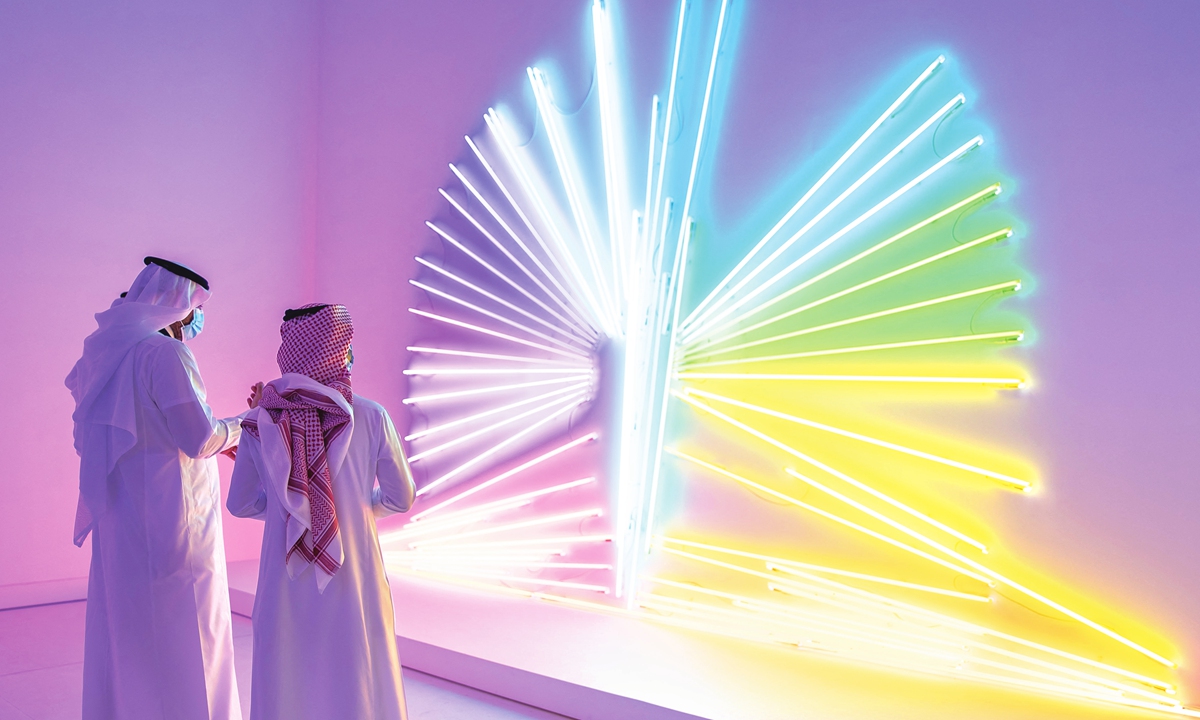
Visitors enjoy the art installation Butterfly during the Noor Riyadh light and art festival in Riyadh, Saudi Arabia, on Saturday. Photo: AFP
As the world slowly begins to emerge from the global COVID-19 pandemic, the kingdom of Saudi Arabia seeks to reengage its population with cultural activities. Noor Riyadh - which translates from Arabic to "Light of Riyadh" - is a citywide light and art festival illuminating the Saudi capital of Riyadh for the next three months.
Due to the global pandemic, 2020 was hardly characterized by cultural events or communal gatherings. But globally, society has gradually begun to emerge from a state of self-preservation, lockdowns and solitude, and begun a return to normalcy. As the Saudi public re-integrates into post-pandemic society, the Noor Riyadh festival aims to transform urban spaces into art that immerses and engages the community.
The Noor Riyadh art festival is an inaugural festival in Saudi Arabia's mission to turn the capital into "one of the world's most competitive and liveable cities by 2030," according to Hosam Al-Qurashi, an advisor to the Royal Commission for Riyadh City. Noor Riyadh is part of a broader art program the Saudi government is introducing in a bid to transform the capital into a gallery without walls by employing over 1,000 pieces of public art throughout the city - turning the capital into "a beautiful, vibrant and cosmopolitan city for everyone to enjoy," says al-Quraishi.
The capital has therefore become a canvas, featuring art by over 60 international artists working in a wide variety of media that includes sculpture, performance, interactive video and music.
The first half of the festival, exhibiting installations under the theme of "Under One Sky" takes place until April 3, primarily in two main districts - the King Abdullah Financial District, and the King Abdulaziz Historical Center.
The exhibition integrates art from notable artists from all over the world - from Saudi Arabia, Argentina, China, France, Germany, Italy, Japan, the Netherlands, Spain, Sweden, the UK and the US - all under Riyadh's sky. Ahmed Mater, one of the Saudi artists participating in the festival, says the festival "creates a dialogue between Saudi artists and exhibited international artists" within the blooming Saudi art scene, which is "young, energetic and full of hope." Over 33 citywide installations have been placed in numerous locations throughout Riyadh, integrating forms of light conceptually through sculpture, projections, interactive shows and immersive pieces.
The second half of the festival, which takes the theme "Light Upon Light," is a retrospective exhibition tracking light art from the 1960s to the present. It runs until June 12 in the King Abdullah Financial District Conference Center.
Saudis are eager to leave the challenges of 2020 behind and look to a "brighter future," according to Director of Riyadh Art Khaled Al-Hazani. The festival, "a celebration of light and art on an unparalleled scale," has already proven popular with Saudis, who have flocked to see the exhibitions on display. Lulwah Al Homoud, one of the Saudi artists exhibiting her work, considers the inaugural festival as the beginning of a "golden age of Saudi art," she says.
Perhaps significantly, some of the installations are not temporary, instead seeking to embed into the semi-permanent fabric of a Riyadh racing towards a futuristic, cosmopolitan vision of society. The festival also features a mix of crowd-pleasing art, as well as a mix of conceptual ingenuity for more discerning lovers of new media art.
As families and individuals walk through artist Daniel Buren's Colored Triangles by Myriad, Saudis are transported to a chiaroscuro of moving color created by light streaming through glass. And Ahmed Mater's Antenna installation is a reminder of the interconnectedness of humanity, as we all collectively emerge from one of the darkest periods of recent human history.
Some works are beautiful and evocative in their simplicity. Lulwah Al Homoud's The Infinite Blue is an immersive video experience. It engages viewers, evoking the particular shade of blue just before the sky turns dark.
Marwah Al-Mugait's May We Meet Again, a visual poem, transports the viewer - simultaneously a participant - into an alternate reality created through a mix of abstract footage and viewer interaction.
My Mother's Rug, by Saeed Gamhawi, is a resounding work with an underlying story, symbolizing the migration of Saudis from quaint villages to big cities. It effectively evokes nostalgia for the artist's hometown, using projection as a tool for material preservation and sensory memory.
Nearly 300 special activities are included in the festival's program, including tours, panels, workshops, family activities, film screenings and music shows. For those living outside of the Kingdom but interested in viewing any activities, they will also be showcased online.
It is the inaugural year for the annual festival, which launched officially on March 18 and is slated to last until June 12.
AFP




